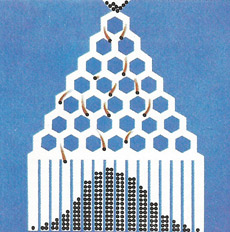

You don't call for a vote of what to do if your house is burning down. The average weight guessed was 1,197 pounds. He got the tickets from the competition organizers and averaged the results. "They were a diverse lot," just like in a democracy, and Galton thought he could prove how stupid the crowd was. Some 800 people had entered this competition. Galton came across a competition to judge the weight of an ox. So Galton was not a big fan of democracy. "Breeding mattered to Galton because he believed that only a few people had the characteristics necessary to keep society healthy," Surowiecki writes. Surowiecki's book begins in 1906, as it takes us on a trip to the Plymouth country fair with British scientist Francis Galton. The best known example of the wisdom of crowds is democracy. Surowiecki gives numerous fascinating examples where collective intelligence proved more accurate than the individual opinions of experts. And in the right circumstances it can be wiser than any one expert. They can't bear the idea of a society thinking for itself.Ĭan the crowd be wise? Yes, according to Surowiecki. That is why we are seeing such a reaction from the remaining fundamentalists. The doctor, the policeman, the teacher, the politician, the priest, the car salesman-they are no longer above question. Experts play a very important role but they are no longer unquestionable. It articulates the "big idea" of the Internet and a big shift in modern society. The Wisdom of Crowds by James Surowiecki is one of the most inspiring books I have read in the last 10 years. The Internet allows customers, and other often-disparate groups, to organize and have their voice heard in a unified and powerful manner. The very first issue of my newsletter that I published on June 24, 1996, was about the potential of collective intelligence. Never before has there been a better medium to tap the collective intelligence than the Web.

Bechstein’s bats were recently discovered in the wood and the colony is thought to be the most northerly breeding roost in the UK.Collective intelligence will be a key competitive advantage in the 21st Century.

Birds including buzzard, goldcrest, treecreeper, lesser and great spotted woodpeckers are regularly seen in the wood and the adjacent meadows and orchards are important for green woodpeckers. Many fungi have been recorded in the wood and it also supports a distinctive flora including herb-Paris, adder’s-tongue fern, violet helleborine, spurge laurel and bird’s-nest orchid. Notable moths include drab looper, rosy footman, Devon carpet and waved black. After careful surveying of the habitat and flowering species in the wood pearl-bordered fritillaries were released into the woodland in 2011 in the hope that they would then naturally re-colonise the wood after a 30 year absence. The wood is also important for other woodland butterflies including silver-washed fritillaries and white admirals. It’s not just brown hairstreak butterflies that visitors to Grafton Wood should keep a look out for.

The two compartments of conifers that were planted in the 1960s have largely been removed in 2010. In many places there is a dense shrub layer of field maple, hawthorn and hazel. The majority of the canopy at Grafton is ash and oak although we also have a small-leaved lime coppice stool that we think must have originally started as one lime tree at least a thousand years ago. We also ensure that there are scrubby areas containing the young blackthorn bushes that are vital for brown hairstreaks to survive. Our management today aims to replicate this tradition and involves widening the rides through the woodland, coppicing and creating glades. Grafton Wood is an ancient semi-natural broad-leaved woodland and, until the 1950s was traditionally managed as coppice-with-standards that provided materials for products such as broom handles, pea sticks, hedge-laying, clothes pegs, spars for thatching and firewood. By working with local landowners and encouraging appropriate maintenance of hedgerows, volunteers from both conservation charities have helped the butterflies to increase in range and in numbers. These elusive butterflies, on the wing in August and September, have been the subject of a long-term project to ensure their survival. The wood is the centre of the only colony of brown hairstreak butterflies in the Midlands. An ancient woodland with coppice and large oaks Jointly owned with Butterfly Conservation, Grafton has been at the heart of one of Worcestershire’s great conservation successes.


 0 kommentar(er)
0 kommentar(er)
